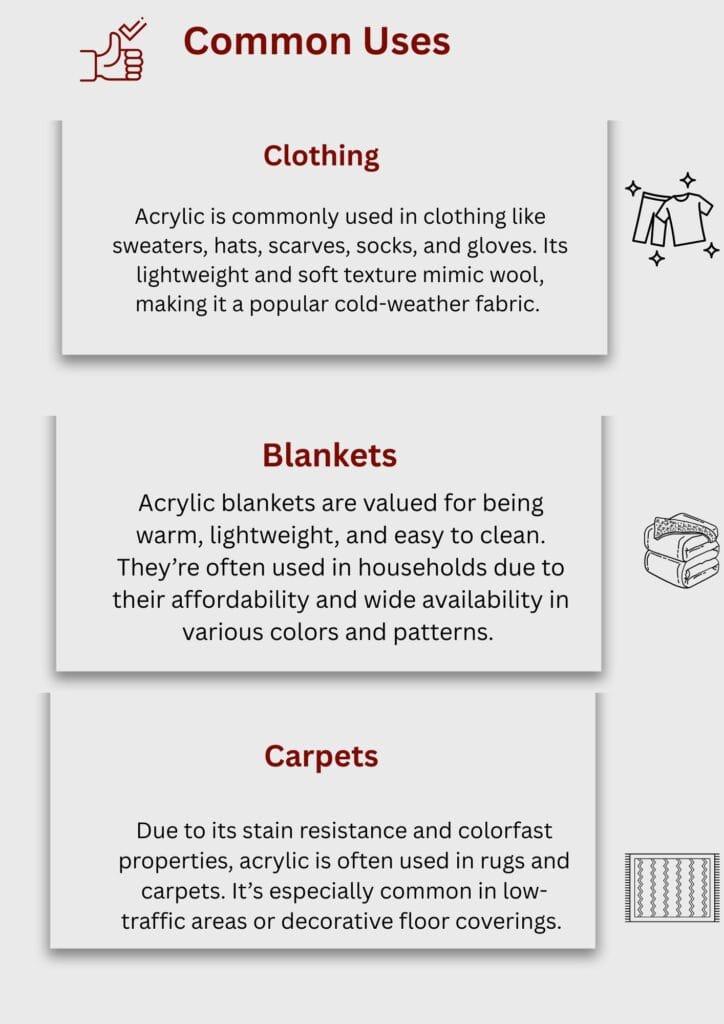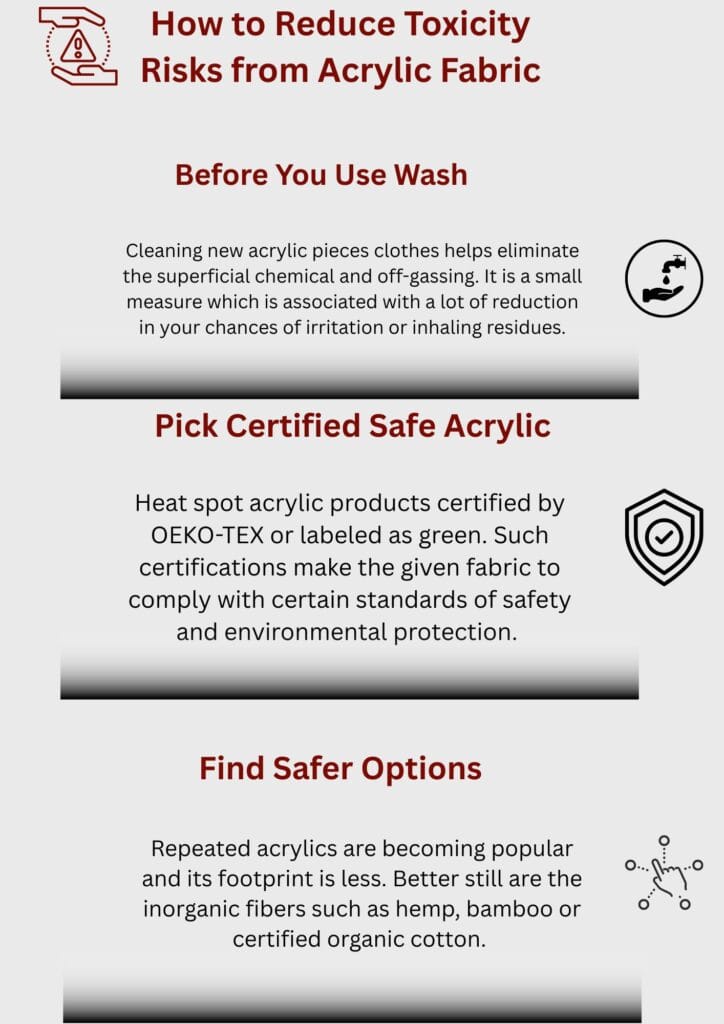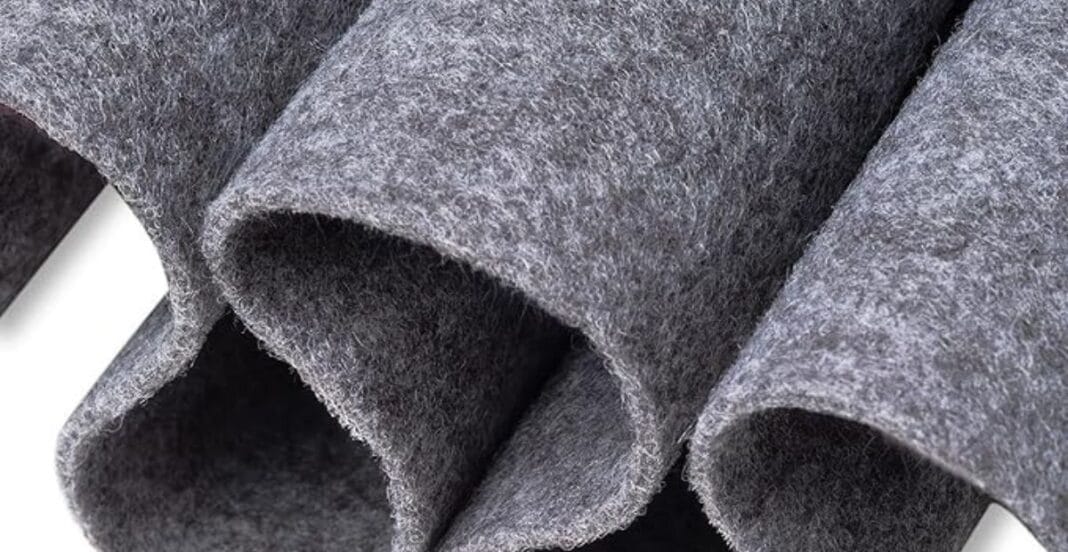Introduction
What is Acrylic Fabric?
A synthetic textile acrylic fabric consists mainly of the material known as acrylonitrile. This resource was initially produced to be an alternative cheaper wool-like material. Acrylic is also favored by the manufacturers because of its smooth touch feel, excellent colour retention as well as wrinkle free and shrink resistance. It is light and warm thereby making it fashionable in low temperature areas.is acrylic fabric toxic
Acrylic fibers are basically a type of plastic, which was designed to resemble natural wool. Nonetheless, it is not breathable like natural materials due to the fact that it is synthetic. It also has a habit of pilling as time goes by, and this affects its long term appearance.
How it is Made? Synthetic Polymer Made out of Petroleum-Made Compounds
Acrylic fabric is produced by the process known as polymerization with the help of petroleum-based chemicals such as acrylonitrile. These drugs are mixed in warm conditions to come up with long chains of molecules that form plastics. What ensues is a man made polymer which is spun into fibers and then woven into cloth.
It is very industrial and non-renewable resources are used in the whole process. A lot of activities in the production process are exposed to the use of toxic substances and some of them might persist to be in the final product. This brings up question such as whether acrylic fabric is poisonous. that we are going to discuss in the course of this paper.
Common Uses (Clothing, Blankets, Carpets, Upholstery)

The fabrics made of acrylic are applied in numerous consumer-related products, primarily due to their durability and low cost. It has become very common in winter attire sweaters, scarves and gloves. It is also found in housewares such as blankets, carpets and upholstery fabrics.
The acrylic is usually applied in outdoor furniture fabric because it cannot fade in sunlight or weather conditions. Its uses might be comfortable, yet the health and environmental impacts need to be regarded.
Is Acrylic Fabric Toxic? (Straight Answer First)
Acrylic fabric tends to be slightly toxic during regular use, but it launches toxic chemicals in a certain environment.
This incorporates high temperature conditions, protracted contact with the skin, and disintegration progressively. Acrylonitrile and formaldehyde are some of the toxic chemicals used during the production process. Though most are washed out by the time they are delivered to the consumers, their traces could still be left.
The issue of the toxicity of acrylic fabric is becoming more frequent with the rise in sensitivities to chemicals, microplastics, and the environment. Therefore, the question of whether acrylic cloth is toxic or not? Not only is it valid but it is also vital.
The Chemicals involved in Fabrication of Acrylics
Acrylonitrile- A Major Material of Health Concerns
The main chemical used in production of acrylic is acrylonitrile. The EPA categorizes it as a likely carcinogen to humans. The acrylonitrile has been associated with occurrence of headache, nausea, and cancer in severe cases. Most vulnerable workers are found in manufacturing environments though it might still be left in completed fabrics.
The small amounts of this may reach the consumers particularly by contact with unwashed acrylic clothing. Thus, the question such as is acrylic fabric toxic is frequently revolving around this compound.
Fabric Finishing Formaldehyde
Certain acrylics are chemically finished using formaldehyde to give them a better wrinkle resistance. Formaldehyde is a recognised irritant and allergen and in excess a possible carcinogen. It can evaporate off the material particularly in hot or humid conditions.
It is one of the reasons that wearing brand new acrylic clothes is highly recommended to wash them prior to the wearing process.
Other Volatile compound organic (VOCs)
Besides acrylonitrile and formaldehyde, a number of volatile organic chemicals (VOCs) can be implicated. These may include solvents, plasticizers and chemical dyes. VOCs will bring about eye irritation, respiratory irritations and/or give rise to indoor air pollution.
Repeated exposures particularly in ill-ventilated places can be hazardous to health. This makes numerous individuals consider replacing synthetic material completely.
Potential Health Risks of Acrylic Fabric
Skin Irritation and Allergies
There are individuals who will develop itchiness, redness and rashes wearing acrylic fabric. This is as a result of chemicals left behind or rougher texture of the fabric as compared to natural fibers. People with weak skin or eczema can respond more intensively.
A change to natural or certified hypoallergenic materials frequently diminishes these reactions in a considerable measure.
Chemical off- gassing Respiratory Problems
The use or wearing of acrylic can also cause some mild respiratory symptoms, mainly to those who are sensitive. Fabrics have the ability to off-gas with chemical emissions over time. Such emissions are more pronounced in confined areas having low circulation.
In addition to that, when acrylic fabric depreciates, it may release microfibers which can either be inhaled or swallowed.
Safety Hazards of Long-Term Exposure
Although most individuals may not be exposed to any long-term risks when exposed to it short-term, long-term exposure may pose greater risk. In particular, exposure (with repetitions) to small doses of acrylonitrian and VOCs can be a health threat over years. Prolonged contacts have been linked to cancerous risks in some studies though not prevalent.
This is a relatively low (end user) risk, but is indicative of the larger question, which has to be asked: Is acrylic fabric toxic in long-term perspective?
Does Acrylic Fabric Release Microplastics?
Contribution to Microplastic Pollution
One of the best plastic fibers causing pollution with microplastic is acrylic. Every time it is being washed, it emits thousands of microscopic fibers that go into the wastewater. These ultimately end up in rivers, the ocean and even tap water sources.
These microplastics are not biodegradable but remain on the environment forever. They wind their way in the food chain, distorting marine life and eventually enter human health.
Environmental and Human Health Effect
Fish and other aquatic organisms eat microplastic made of acrylic fabrics. These particles are harmful causing internal destruction and even death among wildlife. In humans, microplastic can lead to inflammation and can disrupt hormonal patterns.
Then the question, is acrylic fabric toxic, comes up. The person should not only take into account his/her health, but the health of the planet too.
Acrylic vs. Natural Fabrics: Toxicity Comparison
Cotton, Wool and Bamboo versus Acrylonitrile
Fabrics that are natural such as organic cotton, wool and bamboo are deemed safer. They are open breathable, renewable and they are less irritable. Such products would generally not force microplastic and disintegrate more conveniently into nature.
Comparatively, acrylic is produced using fossil fuels and it is non-biodegradable with chances of residual chemicals. Although economical, it has entrusted costs to the environment and health.
Which one is safer to sensitive skin?
Natural fabrics almost always win, when people have allergies or delicate skin. The substances like cotton and bamboo are particularly soft and they are less prone to trapping heat and moisture. Acrylic which is synthetic is harsh on skin and collects perspiration.
Dermatologists and parents usually suggest that to treat skin problems or take care of babies, people should avoid using synthetic materials.
Is Acrylic Fabric Safe for Babies & Pets?
Baby Clothes and Acrylic-A Cautionary Word
A lot of parents do not use acrylic materials to make baby garments and covers. Babies are sensitive and with developing immune systems. Chemical residues, heat retention and harsh textures are fair concerns.
That is why it is advisable to use fabrics that are natural, organic or certified safe among infants.
Pet safety Hazards of Pets That Bite Fabric
Blankets and furniture are mostly chewed and licked by pets particularly, dogs and cats. In case they are acrylic, they can consume dangerous strings of fibers or chemicals. They can lead to gastrointestinal discomfort or poisonous effects.
It is safer to use natural or pet friendly materials in constructing bedding and toys.
How to Reduce Toxicity Risks from Acrylic Fabric

Before You Use Wash
Cleaning new acrylic pieces clothes helps eliminate the superficial chemical and off-gassing. It is a small measure which is associated with a lot of reduction in your chances of irritation or inhaling residues.
Avoid the use of washing detergents that contain fragrances and warm water to help reduce the escape of microplastics during wash.
Pick Certified Safe Acrylic
Heat spot acrylic products certified by OEKO-TEX or labeled as green. Such certifications make the given fabric to comply with certain standards of safety and environmental protection. They provide a sense of security to health-savvy customers with a question on their mind, “is acrylic fabric toxic?”
Find Safer Options
Repeated acrylics are becoming popular and its footprint is less. Better still are the inorganic fibers such as hemp, bamboo or certified organic cotton. These alternatives are less harmful on the skin and to the planet.
Ecology of Acrylic Fabric
Non-Biodegradability
Acrylic cloth is not natural degrading. Hundreds of years are needed to break down in land fills. This extended life is part of the world waste problem and explains why this material is not sustainable.
After they have been discarded, acrylics further contaminate the environment, as they break down slowly using the process of chemical leaching and they break to form plastic fragments.
Production and Washing Unwarranted Pollution
During the manufacturing process, greenhouse gases, toxic waste as well as harmful byproducts are emitted. Each wash release causes minute plastic particles to go in to the water. These fibers cause a challenge in filtration and they build up with time in the water ecosystem.
The pollution is of concern to the environmentalists as well as to the consumers.
Conclusion
Then, is acrylic cloth poisonous? It varies with situation. Its production, its chemical composition and its overall impact on the environment are questionable although it is not dangerous when used in small quantities. In case of sensitive skins, infants, or pets, it is prudent to take natural or certified ones. Even though acrylic fabric is comfortable and affordable, better decisions result in safer lives- among people and between the planet and us.


